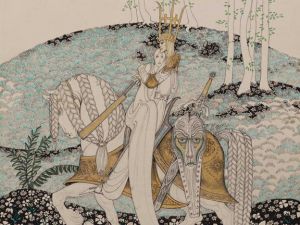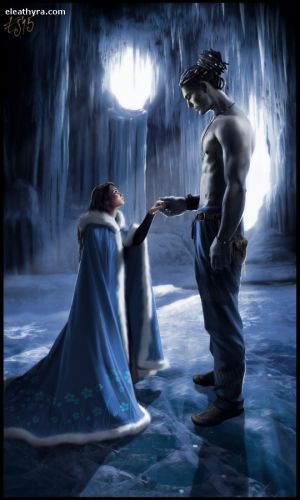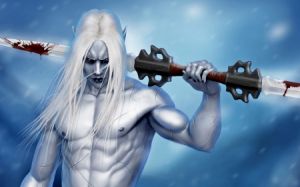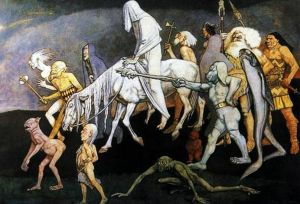Bem-vindo aos nossos novos jogadores brasileiros. Por favor leia
Difference between revisions of "History Vol 1: The Muiri-Aelfeyn Debate"
From Sanctuary Shard
MamaWillow (talk | contribs) (Created page with "category:Lore My esteemed students, Our class today is on the origins of the Muiri and their tie, if any to the Aelfeyn. It has been centuries since a class on this to...") |
MamaWillow (talk | contribs) |
||
| (21 intermediate revisions by the same user not shown) | |||
| Line 1: | Line 1: | ||
[[category:Lore]] | [[category:Lore]] | ||
| + | {| | ||
| + | |- style="vertical-align:top;" | ||
| + | |<I>My esteemed students, | ||
| − | + | Our class today is on the origins of the [[Muiri]] and their tie, if any to the [[Aelfeyn]]. It has been centuries since a class on this topic could be presented publically. As the power of the Thorn King has finally been broken, new theories on many subjects once deemed “unacceptable” by the patriarchy have gained new exposure. | |
| − | + | Historically speaking, documented accounts of the [[Aelfeyn]] predate that of the [[Muiri]] by more than five centuries. As you have all learned by now, historical accounts are written by the victorious, not by the defeated. During the age of the Thorn King, scholars postulated quite strongly that the [[Aelfeyn]] and the [[Muiri]] were not natural beings but were in fact demons summoned to the mortal plane to wreck unholy destruction upon the good works done in the name of The Thorn King, a mostly human God. | |
| − | |||
| − | Historically speaking, documented accounts of the Aelfeyn predate that of the Muiri by more than five centuries. As you have all learned by now, historical accounts are written by the victorious, not by the defeated. During the age of the Thorn King, scholars postulated quite strongly that the Aelfeyn and the Muiri were not natural beings but were in fact demons summoned to the mortal plane to wreck unholy destruction upon the good works done in the name of The Thorn King, a mostly human God. | ||
| − | |||
| − | |||
| − | |||
| − | |||
But if we go back more than a millennium, before the rise of the Thorn King, we find numerous accounts which describe a people distinctly different from all recordings of Human or Hoggur. It is important to remind students that in the beginning no one confused Hoggur with any other race, the blending of appearances wouldn’t come until this last era. The accounts of these other people are vague, disparate and often contradictory. | But if we go back more than a millennium, before the rise of the Thorn King, we find numerous accounts which describe a people distinctly different from all recordings of Human or Hoggur. It is important to remind students that in the beginning no one confused Hoggur with any other race, the blending of appearances wouldn’t come until this last era. The accounts of these other people are vague, disparate and often contradictory. | ||
| − | From the far | + | From the far northeast we have accounts of an [[Aelfeyn]] people, known as the [[Alfar]], with sharp nordic features arriving in the company of even taller powerfully built Hoggur. The race is described as being, “easily ah head or two taller than any human with skin like milk and hair like snow. They came with a group of Hoggur that called themselves [[Jotunn]]. These new Hoggur were even taller than the [[Alfar|snow elves]], powerfully built with dark haired with bluish-grey skin.” The [[Alfar]] possessed complex temperaments, strong passions and an ability to shape change during battle. We believe that it was the berserker rage of the [[Alfar]] which infused the human bloodline with wolf and ursine lycanthropy. |
| − | |||
| − | |||
| − | |||
| − | |||
| − | |||
| − | |||
| + | The [[Alfar]] would inter-breed with the [[Jotunn]], a group of them known as the [[Alfar|Trow]] would branch off and head north never to be heard from again. The rest of the [[Alfar]] would stay in Midrvegr and intermarry with [[Jotunn]] and humans until the mixed ancestry was simply called [[Alfar|Alfarian]]. | ||
| + | From the far northwest we would hear of a race of [[Aelfeyn]], called the [[Noldorian|Noldorians]], arriving with a group of humans who are known to us as the Dúnedain. The [[Noldorian]] were described as somewhat taller than humans they arrived with, dark haired and grey eyed. The Noldor were described as being intellectually gifted, powerfully built, brave and proud. | ||
| − | + | A third wave of [[Aelfeyn]] would arrive on the borders of Raeyithia and fight with a group of red-haired Hoggur known as [[Fomorian |Fomorians]], finally driving the [[Fomorian|Fomorians]] north. They would at first be called the Children, like that of another [[Aelfeyn]] race already living in the southern part of Cuivienen, but a distinction would be made and they would eventually be known as the [[Tuatha De Danann]], or the [[Tuatha De Danann|Children of Dana]] to distinguish them from the [[Children of the Forest]]. The [[Children of the Forest]] are the oldest known race of [[Aelfeyn]] and have no documented arrival date. They are believed to be origin races like that of the Hoggur. | |
| − | There is a great deal of confusion between the two people, the Children of the Forest and the Children of Dana. We believe that the confusion is caused by a slow invasion transitioning from one race to the next. The Children of the Forest were dark skinned and dark haired, and while they lived in hills and mounds were obviously not Hoggur. They were too delicate and petite to ever be confused with the Hoggur who they often shared their underground homes with. They were natural shapeshifters skilled in camouflage and glamour. Reports of them include descriptions with horns, tails, fur, bark and branches. | + | There is a great deal of confusion between the two people, the [[Children of the Forest]] and the [[Tuatha De Danann|Children of Dana]]. We believe that the confusion is caused by a slow invasion transitioning from one race to the next. The [[Children of the Forest]] were dark skinned and dark haired, and while they lived in hills and mounds were obviously not Hoggur. They were too delicate and petite to ever be confused with the Hoggur who they often shared their underground homes with. They were natural shapeshifters skilled in camouflage and glamour. Reports of them include descriptions with horns, tails, fur, bark and branches. |
| − | Unlike these first people of the mound, called | + | Unlike these first people of the mound, called [[Children of the Forest|Daoine Sídhe]], the [[Tuatha De Danann|Children of Dana]] were taller, fair skinned and often red-haired. Unlike the other [[Aelfeyn]] races they possessed delicate features, pointed ears and triple color irises. They brought with them the arts, sciences and a complex pantheon of gods and goddesses to explain the world of Cuivienen that persists today in Raeyithia. Noble of bearing, arrogant and magically powerful, the [[Children of the Forest]] would dub them “The [[Tuatha De Danann|Gentry]]” or the "[[Tuatha De Danann|Áes dána]]". |
| − | As is normal with such slow invasion the races would begin to interbreed, with the Gentry rising to dominance in the kingdom over that of the humans and | + | As is normal with such slow invasion the races would begin to interbreed, with the [[Tuatha De Danann|Gentry]] rising to dominance in the kingdom over that of the humans and [[Children of the Forest|Daoine Sídhe]]. The gods of the [[Tuatha De Danann|Gentry]] would push into many areas of Cuivienen, even as far as Emlyn where the goddess Dana would become the god Dana. |
| − | In the beginning, the Gentry (Children of Dana) would move into the hills and mounds of the Daoine Sídhe (Children of the Forest) forcing the Sidhe and many of the Hoggur father down and out. Eventually the earth magic of the mounds would fail, Underhill would form, and the Gentry would move above ground founding the city of Tarasinau. | + | In the beginning, the [[Tuatha De Danann|Gentry]] ([[Tuatha De Danann|Children of Dana]]) would move into the hills and mounds of the [[Children of the Forest|Daoine Sídhe]] (Children of the Forest) forcing the Sidhe and many of the Hoggur father down and out. Eventually the earth magic of the mounds would fail, Underhill would form, and the [[Tuatha De Danann|Gentry]] would move above ground founding the city of Tarasinau. |
| − | It is easy to understand why the first Aelfeyn race would be confused with that of the arriving Tuatha de Dannan. But it is these original Children of the Forest that we believe formed the race of Muiri as well as being the origin race for both witches and most of the cat based lycanthropes. | + | It is easy to understand why the first [[Aelfeyn]] race would be confused with that of the arriving Tuatha de Dannan. But it is these original Children of the Forest that we believe formed the race of [[Muiri]] as well as being the origin race for both [[Witch|witches]] and most of the cat based [[Lycanthrope|lycanthropes]]. |
| + | | | ||
| + | [[image:Alfar.jpg|thumb|Alfar]] | ||
| + | [[image:Jotunn.jpg|thumb|Jotunn]] | ||
| + | [[image:Trow.jpg|thumb|Trow]] | ||
| + | [[image:Fomorians.jpg|thumb|Fomorians]] | ||
| + | |} | ||
Latest revision as of 21:01, 30 June 2020
| My esteemed students,
Our class today is on the origins of the Muiri and their tie, if any to the Aelfeyn. It has been centuries since a class on this topic could be presented publically. As the power of the Thorn King has finally been broken, new theories on many subjects once deemed “unacceptable” by the patriarchy have gained new exposure. Historically speaking, documented accounts of the Aelfeyn predate that of the Muiri by more than five centuries. As you have all learned by now, historical accounts are written by the victorious, not by the defeated. During the age of the Thorn King, scholars postulated quite strongly that the Aelfeyn and the Muiri were not natural beings but were in fact demons summoned to the mortal plane to wreck unholy destruction upon the good works done in the name of The Thorn King, a mostly human God. But if we go back more than a millennium, before the rise of the Thorn King, we find numerous accounts which describe a people distinctly different from all recordings of Human or Hoggur. It is important to remind students that in the beginning no one confused Hoggur with any other race, the blending of appearances wouldn’t come until this last era. The accounts of these other people are vague, disparate and often contradictory. From the far northeast we have accounts of an Aelfeyn people, known as the Alfar, with sharp nordic features arriving in the company of even taller powerfully built Hoggur. The race is described as being, “easily ah head or two taller than any human with skin like milk and hair like snow. They came with a group of Hoggur that called themselves Jotunn. These new Hoggur were even taller than the snow elves, powerfully built with dark haired with bluish-grey skin.” The Alfar possessed complex temperaments, strong passions and an ability to shape change during battle. We believe that it was the berserker rage of the Alfar which infused the human bloodline with wolf and ursine lycanthropy. The Alfar would inter-breed with the Jotunn, a group of them known as the Trow would branch off and head north never to be heard from again. The rest of the Alfar would stay in Midrvegr and intermarry with Jotunn and humans until the mixed ancestry was simply called Alfarian. From the far northwest we would hear of a race of Aelfeyn, called the Noldorians, arriving with a group of humans who are known to us as the Dúnedain. The Noldorian were described as somewhat taller than humans they arrived with, dark haired and grey eyed. The Noldor were described as being intellectually gifted, powerfully built, brave and proud. A third wave of Aelfeyn would arrive on the borders of Raeyithia and fight with a group of red-haired Hoggur known as Fomorians, finally driving the Fomorians north. They would at first be called the Children, like that of another Aelfeyn race already living in the southern part of Cuivienen, but a distinction would be made and they would eventually be known as the Tuatha De Danann, or the Children of Dana to distinguish them from the Children of the Forest. The Children of the Forest are the oldest known race of Aelfeyn and have no documented arrival date. They are believed to be origin races like that of the Hoggur. There is a great deal of confusion between the two people, the Children of the Forest and the Children of Dana. We believe that the confusion is caused by a slow invasion transitioning from one race to the next. The Children of the Forest were dark skinned and dark haired, and while they lived in hills and mounds were obviously not Hoggur. They were too delicate and petite to ever be confused with the Hoggur who they often shared their underground homes with. They were natural shapeshifters skilled in camouflage and glamour. Reports of them include descriptions with horns, tails, fur, bark and branches. Unlike these first people of the mound, called Daoine Sídhe, the Children of Dana were taller, fair skinned and often red-haired. Unlike the other Aelfeyn races they possessed delicate features, pointed ears and triple color irises. They brought with them the arts, sciences and a complex pantheon of gods and goddesses to explain the world of Cuivienen that persists today in Raeyithia. Noble of bearing, arrogant and magically powerful, the Children of the Forest would dub them “The Gentry” or the "Áes dána". As is normal with such slow invasion the races would begin to interbreed, with the Gentry rising to dominance in the kingdom over that of the humans and Daoine Sídhe. The gods of the Gentry would push into many areas of Cuivienen, even as far as Emlyn where the goddess Dana would become the god Dana. In the beginning, the Gentry (Children of Dana) would move into the hills and mounds of the Daoine Sídhe (Children of the Forest) forcing the Sidhe and many of the Hoggur father down and out. Eventually the earth magic of the mounds would fail, Underhill would form, and the Gentry would move above ground founding the city of Tarasinau. It is easy to understand why the first Aelfeyn race would be confused with that of the arriving Tuatha de Dannan. But it is these original Children of the Forest that we believe formed the race of Muiri as well as being the origin race for both witches and most of the cat based lycanthropes. |



